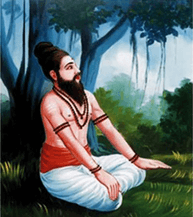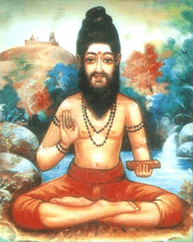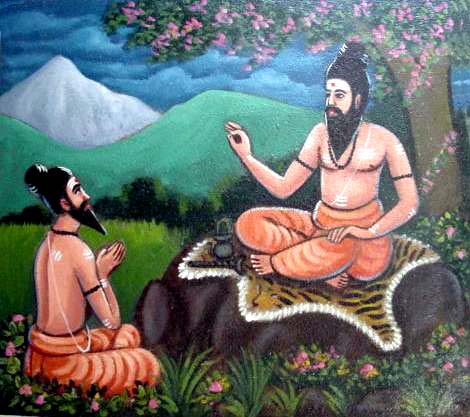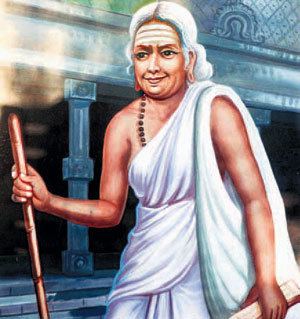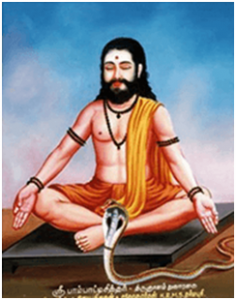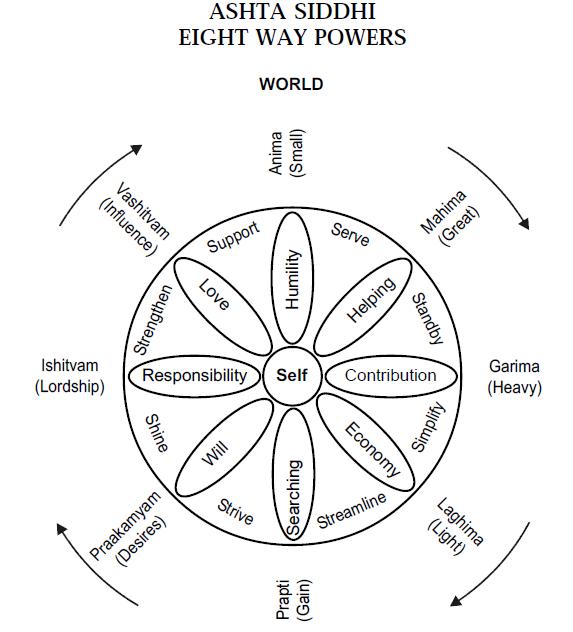
#Thread
Hello Dear Tweeples, today we’re gonna look at a Siddhar who made significant contribution in building the renowned Brihadeeswara Temple – Karuvoorar Siddhar. We’ll come to that aspect of things a bit later, first let’s get to know about the Siddhar’s life.
@LostTemple7
Hello Dear Tweeples, today we’re gonna look at a Siddhar who made significant contribution in building the renowned Brihadeeswara Temple – Karuvoorar Siddhar. We’ll come to that aspect of things a bit later, first let’s get to know about the Siddhar’s life.
@LostTemple7

There are different theories about Karuvoorar Siddhar’s birth & origin. While one theory suggest that he is the same as ‘Karuvoorar Devar’ – a Shaiva Saint. The other – widely accepted – theory is that he’s born in a family of Sthapathis or murti architects from Karuvoor +
+ of the then Chola Kingdom (present day Karur). Hence, he’s known as ‘Karuvoorar’.
While there are little facts to support the first theory, the second theory is endorsed by none other then Sri Agathiya Muni Siddhar – one of THE greatest Siddhar in his work ‘Agastyar 12000’.
While there are little facts to support the first theory, the second theory is endorsed by none other then Sri Agathiya Muni Siddhar – one of THE greatest Siddhar in his work ‘Agastyar 12000’.

In 4th Chapter of this book, verse 452 he talks about the origin of Karuvoorar Siddhar. The verse is a below:
துணிந்துமே சிலைக்கருவு செய்ய வென்று
துப்புரவாய்க் குடிகளிட மார்க்கம் சென்று
மணியான மணியுடனே குடவன் தானும்
மன்னவனே நவலோகம் ஒன்றாய்ச் சேர்த்து
@RajiIndustani @rspchary
துணிந்துமே சிலைக்கருவு செய்ய வென்று
துப்புரவாய்க் குடிகளிட மார்க்கம் சென்று
மணியான மணியுடனே குடவன் தானும்
மன்னவனே நவலோகம் ஒன்றாய்ச் சேர்த்து
@RajiIndustani @rspchary
அணியான கருவுதனில் அமைத்துமே தான்
அப்பனே பிரதமைகள் உருவு செய்து
தணியான கருவுதனை விற்று உண்டு
சதா காலம் சீவனங்கள் செய்திட்டாரே
இட்டாரே கருவூரார் தந்தை தாய்மார்
எழில் பெரிய தேவதாஸ்தானங்கள் தேடி
Gist of the verse is as follows:
@HelloNNewman @Kishoreciyer1
அப்பனே பிரதமைகள் உருவு செய்து
தணியான கருவுதனை விற்று உண்டு
சதா காலம் சீவனங்கள் செய்திட்டாரே
இட்டாரே கருவூரார் தந்தை தாய்மார்
எழில் பெரிய தேவதாஸ்தானங்கள் தேடி
Gist of the verse is as follows:
@HelloNNewman @Kishoreciyer1
The parents of Karuvoorar Siddhar were dedicated to creating temple idols, by visiting various places of purity and divine significance, while architecting idols by forging the nine metals, and they honed these skills to make a livelihood.
@BahuRaani @YoginiPratibha
@BahuRaani @YoginiPratibha
Karuvoorar Siddhar’s parents had great regards for Rishis and often served them. Obliging the parents for their selfless service, many Rishis taught Karuvoorar in his early life. As Karuvoorar grew up, he got inspired by the spiritual works of Kamala Muni Siddhar. @desi_thug1
Once on his visit to Thiruvaduthurai, Bogar Siddhar was visited by Karuvoorar, who requested Bogar Siddhar to accept him as a disciple. Under Bogar Siddhar’s tutelage, Karuvoorar learnt about Siddha aspects, including science, Yoga and jnana.
@krithikasivasw @Krishna_Priiya
@krithikasivasw @Krishna_Priiya
Bogar Siddhar initiated Karuvoorar Siddhar in the worship of Ambal (Karuvoorar Siddhar’s ‘kuladevi’). The great Divine Mother gave him Darshana and graced him with the rise of Kundalini. Thus, we find many of Karuvoorar’s verses referring to Ambal as Devi, Kundalini and overall +
+ feminine aspect of Universe.
Coming to how Karuvoorar helped the great King Raja Raja Chola with the Brihadeeswara Temple. The temple is no doubt a great marvel and way ahead of it’s time, this lends credence to Raja Raja Chola as a visionary King.
@Lost_History1 @InfoVedic
Coming to how Karuvoorar helped the great King Raja Raja Chola with the Brihadeeswara Temple. The temple is no doubt a great marvel and way ahead of it’s time, this lends credence to Raja Raja Chola as a visionary King.
@Lost_History1 @InfoVedic

However, during the construction of the temple, the King faced a great challenge. One of them being consecration of Shiva Lingam in the temple. It is believed that Bogar Siddhar advised King Raja Raja Chola to seek advise of Karuvoorar Siddhar in accomplishing the task. @shri_v
It is with Karuvoorar’s advise that the Shiva Lingam was installed in the temple. The presence of a shrine dedicated to Karuvoorar Siddhar in the temple complex (at the rear) is seen as a proof to this.
@hathyogi31 @Elf_of_Shiva_ @Itishree001 @Anshulspiritual @Padmaavathee

@hathyogi31 @Elf_of_Shiva_ @Itishree001 @Anshulspiritual @Padmaavathee
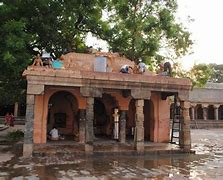

There’s also a painting depicting Karuvoorar Siddhar and Raja Raja Chola in the temple.
Like his other peer Siddhars, Karuvoorar Siddhar’s works is not only limited to devotion and mystical aspects. His discoveries and improvements in the practice of alchemy are humongous.
Like his other peer Siddhars, Karuvoorar Siddhar’s works is not only limited to devotion and mystical aspects. His discoveries and improvements in the practice of alchemy are humongous.

Siddhar Karuvoorar is distinguished for his work of “Attama Siddhi”– the eight major types of siddhi attainment. In his work Karuvoorar Vatha Kaaviyam – 700, he has given a biography of the Pathinen Siddhargal and other Siddhas.
@Tanvangi17 @Dharma_Chant @VedicWisdom1
@Tanvangi17 @Dharma_Chant @VedicWisdom1
He attained samadhi in Sri Kalyana Pasupatheeswarar temple in Karur.
Karuvurar Siddhar Books/Works:
karuvoorar vaatha kaaviyam 700 (கருவூரார் வாதகாவியம்–700)
karuvoorar vaithiyam 500 (கருவூரார் வைத்தியம்–500)
karuvoorar yoga gnanam 500 (கருவூரார் யோகஞானம்–500)
@chittukuruvi4
Karuvurar Siddhar Books/Works:
karuvoorar vaatha kaaviyam 700 (கருவூரார் வாதகாவியம்–700)
karuvoorar vaithiyam 500 (கருவூரார் வைத்தியம்–500)
karuvoorar yoga gnanam 500 (கருவூரார் யோகஞானம்–500)
@chittukuruvi4
karuvoorar pala thirattu 300 (கருவூரார் பலதிட்டு–300)
karuvoorar gurunool soothira 105 (கருவூரார் குருநூல் சூத்திரம்–105)
karuvoorar poorana gnanam 100 (கருவூரார் பூரணஞானம்–100)
karuvoorar meisurukkam 52 (கருவூரார் மெய்சுருக்கம்–52)
@vedvyazz @mayfair1958
karuvoorar gurunool soothira 105 (கருவூரார் குருநூல் சூத்திரம்–105)
karuvoorar poorana gnanam 100 (கருவூரார் பூரணஞானம்–100)
karuvoorar meisurukkam 52 (கருவூரார் மெய்சுருக்கம்–52)
@vedvyazz @mayfair1958
karuvoorar sivagnana petham 42 (கருவூரார் சிவஞானபோதம்–42)
karuvoorar karppa vithi 39 (கருவூரார் கற்ப விதி–39)
karuvoorar muppu soothiram 30 (கருவூரார் முப்புசூத்திரம்–30)
karuvoorar attamaasiththu (கருவூரார் அட்டமாசித்து (மாந்திரீகம்))
karuvoorar karppa vithi 39 (கருவூரார் கற்ப விதி–39)
karuvoorar muppu soothiram 30 (கருவூரார் முப்புசூத்திரம்–30)
karuvoorar attamaasiththu (கருவூரார் அட்டமாசித்து (மாந்திரீகம்))
Hope you enjoyed reading about a Siddhar who played significant role in building one of the greatest temples in Indian history.
Goodbye to all till we meet again, when I bring to you some interesting information about another Siddhar. Till then, take care!
@BesuraTaansane
Goodbye to all till we meet again, when I bring to you some interesting information about another Siddhar. Till then, take care!
@BesuraTaansane
Have a great rest of the day and week ahead!
Content Source: anaadifoundation.org and tknsiddha.com
Pic Source: Bing
Content Source: anaadifoundation.org and tknsiddha.com
Pic Source: Bing
• • •
Missing some Tweet in this thread? You can try to
force a refresh

